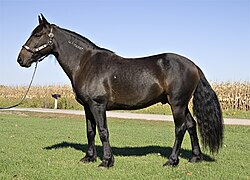Pryor Mountains feral horse - 2009
Autor/Urheber:
Billings Field Office. Bureau of Land Management. U.S. Department of the Interior. Pryor Mountain Wild Horse Range/Territory. Environmental Assessment MT-10-08-24 and Herd Management Area Plan. May 2009, p. 52.
Größe:
816 x 613 Pixel (158460 Bytes)
Beschreibung:
A feral or "wild" horse in 2009 at the Pryor Mountains Wild Horse Range in Montana in the United States. This image depicts the classic features of this animal's unique genetic makeup. DNA testing has shown that the Pryor Mountains herd is directly descended from the Spanish barb horse, brought to North America in the mid 1600s A.D. by the Spanish. The horse is generally 13-15 hands high, and weigh 700 to 800 pounds (more if raised in captivity). The majority of Pryor Mountains horses are dun or grullo in color, but some are red or blue roan, bay, black, chestnut, and (rarelhy) buckskin in color. They minimally express calico paints. Pryor Mountains horses look much like primitive horses, with a dorsal stripe down the back, stripes on the withers, and tiger stripes on the legs. Most have just five lumbar vertebrae (an anatomical feature distinctive of primitive horses), although some have a fifth and sixth vertebrae which are fused.
Pryor Mountains horses have medium-length necks, long manes and tails, convex or straight heads, wide-set eyes, and hooked ears. The forehead is broad, and tapers well to the muzzle. The teeth meet evenly, upper lip is usually longer than the lower, and the nostrils are small and crescent shaped. The horses have sloped croups and low tail-sets, the shoulders are long and sloping, the withers are prominent, and the chest is medium to narrow in width. The hooves are hard and ample, and the horse exhibits the classic paso gait.
Weitere Informationen zur Lizenz des Bildes finden Sie hier. Letzte Aktualisierung: Sat, 06 Jan 2024 20:16:13 GMT
Relevante Bilder
Relevante Artikel
Mustang (Pferd)
Mustangs sind wild lebende Pferde in Nordamerika. Ihre Vorfahren waren Hauspferde, die von den spanischen Konquistadoren ab dem 16. Jahrhundert in die Neue Welt eingeführt wurden. Daher sind Mustangs aus biologischer Sicht keine Wildpferde.
Viele dieser Tiere entkamen (Gefangenschaftsflüchtlinge), verbreiteten sich bis zum Ende des 18. Jahrhunderts über große Teile Nordamerikas (→ Ausbreitungskarte im Artikel „Prärie-Indianer“), verwilderten und etablierten eine stabile Population.
Hintergrundinformationen zur Pferdebewertung und -zucht finden sich unter: Exterieur, Interieur und Pferdezucht.
.. weiterlesen







